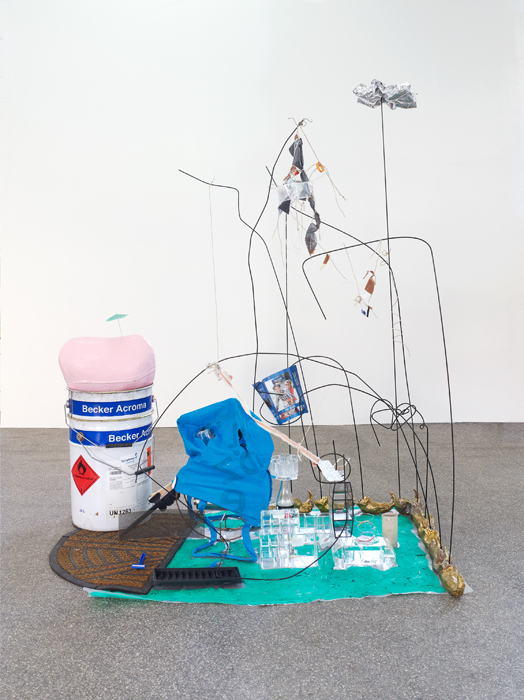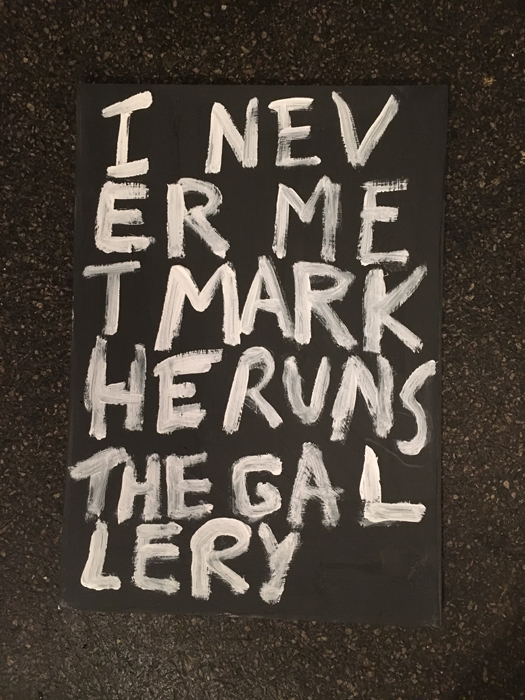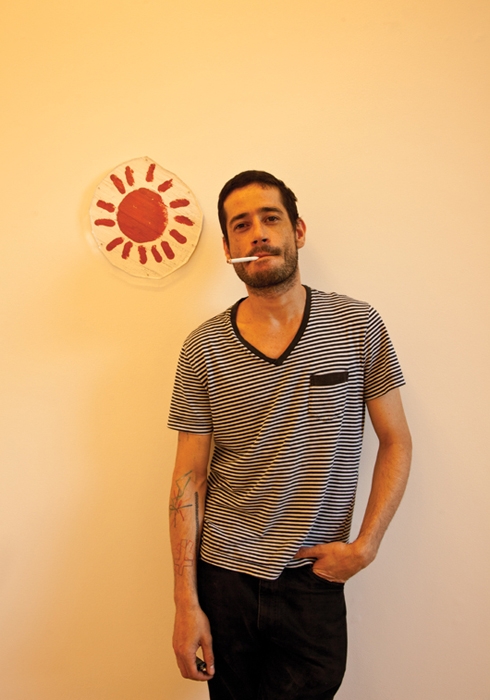Over 24 hours, Adriano Costa and I exchanged a flurry of emails. Back and forth, we volleyed with the kind of freshness that is usually absent in correspondence interviews. Throughout the day, I responded on my phone, wherever I happened to be: doctor’s office, market, car, studio. The process seemed appropriate, since Costa’s art is an accumulation of the moments of his life: an expanding catalogue of his ever-wandering attention.
Costa seeks observational freedom. He absorbs the forms of his world – tiles, bottles, slabs, skis, umbrellas – sometimes integrating them into his work, sometimes making new work informed by their humble energy. Nevertheless, he rejects the notion of ‘found’ materials, seeing all things, from bronze to plastic, as equal.
Primarily a sculptor, he also brings his material sensitivity to painting, drawing, collage and writing, all of which fill his vast, meticulous installations. Much of Costa’s work is in the act of arranging. A wall of bricks lays flat on the floor; rugs hang from the ceiling; a constellation of detritus crawls across the corner of a room. His environments suggest an idiosyncratic, anarchic culture of his own making, where he can do whatever he wants. He is both careful and sloppy, minimal and busy, highly formalist and crassly lowbrow. Often, he slips subversive humour into his gestures. He engraves the phrase ‘I see a penis’ into a chunk of marble. He casts ratty doormats in gold and stick-figures in bronze.
Based in São Paulo – where he was born in 1975, and where he studied – Costa has the optic wit and haptic awareness that has come to define much of contemporary Latin American art. As we corresponded, Costa was putting the finishing touches to his show wetANDsomeOLDstuffVANDALIZEDby- THEartist at the Kölnischer Kunstverein. Between our exchanges, he posted to Instagram pop-cultural images, street scenes from Berlin (where he was staying) and work underway for the show: wild collages and permutations of colourful tiles, accompanied by poetic comments and titles. (From a recent post: ‘Have Another Little Piece Of My Heart N.O.W. You Know You Got It If It Makes You Feel Good – You Wanna Piss On Me, BritNy.’)
Costa’s writing often makes its way into his work via philosophical declarations and cynical musings. Over email, however, his communication felt intimate and open, emotional and self-effacing, but always with a cryptic overtone. His blazingly typed, second-language English required that I reread and decode whatever he had just sent my way, jarring me out of my mindless email routine and into engagement. ‘Man,’ he wrote at the end of our rally, ‘I go buy some bread is 7:10 Rewe [his local Berlin supermarket] is open. Speak later… Where are you?’
***
ROSS SIMONINI I’ve heard you use the term ‘pre-sculptoric’ to describe what you do. What does that mean?
ADRIANO COSTA This pre-sculptoric thing comes from a peculiar moment from my work, around my first series of ‘carpets’ [Tapetes, 2009–12, a collection of fabrics Costa arranged on the floor], when I was living a very delicate period of my life. I was just getting out of my first crack crisis (yes, I was addicted to crack) without a single penny and I suddenly started – I don’t know why, exactly – paying attention to the organisation of clothes, pieces of paper, etc. It was extremely beautiful.
I still think the spiritual way is THE WAY, the only way for changing something deeply, including the arts
And so: in a very meditational, serious, reverential way, I spent every single morning from 2013, I guess, making geometrical compositions with all sorts of things I found in my house, my friend’s house and my parents’ house. It became a kind of delicious obsession. Every day, even if I tried really hard, it was absolutely impossible to repeat the same forms and dynamics. I went deep into the peculiar geometry of Brazilian artists from the late 1960s and 70s, when art was really close to meditation or therapy. When I look to them, I cry. It is so sophisticated, human, honest. C’mon, Lygia Clark and Hélio Oiticica are still playing with our heads like kids, making fun. Haha. Love them.
So, my carpets were completely free, without anything to make them fixed. That was the reason I called them pre-sculptoric. Antispeculative works, stillborn works. Some collectors bought them. My position was and still is the same: do what you want. They live without me. Hahaha.
RS Why did you lose interest in meditation and therapy?
AC I still think the spiritual way is THE WAY, the only way for changing something deeply, including the arts – I just don’t know how to do it and I am sure the way all those shows, big shows, have been doing it, calling it ‘shamanism’, is pure, outrageous bullshit. At least they are trying, perhaps. We are humans. We do bad things. Me, myself: I go for sculptures and paintings and drawings and videos. No messing with the Gods for now. Too many problems here in my kitchen. So many predators.

RS What ‘big shows’ are you referring to?
I post everything on Instagram. Absolutely everything. I always have to hear friends saying, hey, keep your works secret blah blah blah. I don’t give a fucking shit. This is about sharing
AC All the should see shows from the last four or five years have one or two works or a ‘segment’ dedicated to spirituality in Europe, in Brazil. In my country, it is a shame because the curators install indigenous houses inside of museums and galleries, but actually did not contribute or try to make something against the genocide – physical and cultural – that the indigenous communities are victims of. Seriously, they will disappear SOON, REALLY SOON. It’s terrible. Once I was in a group show at the Modern Institute in Glasgow and the work was hundreds of white T-shirts printed with the word ‘ayahuasca’, ’cause I was so mad with the exploitation of ayahuasca tea by white middle-class people. This was in 2014. After this, someone [Noah Baumbach] made a movie [While We’re Young, 2014] of Naomi Watts and Ben Stiller drinking the tea in Williamsburg in a pretentious and stupid hipster New Yorker commune. Ha ha. In 2017 there were [ceremonial ayahuasca environments] at the Venice Biennale. I am not judging any artist or curator. I’m just asking why the magic, the hallucination, the exoticism is so interesting, but it’s not permitted to talk about and count how many indigenous people (the owners of the Amazon forest where the plant, the tea grows) were killed today. Closing our eyes to the pile of bodies is very easy. Again: we are humans, we do wrong, but c’mon, leave the forest, leave the indigenous alone.
RS How did crack affect your work while you were using it?
AC Crack, like all other drugs (as I am addicted to all of them), doesn’t have any direct effect on my work. As I do respect my profession, I don’t mix the things. When I am high I prefer to not even look to my babies [meaning his art]. They don’t deserve my evils.
RS Do you find that your work has changed significantly while being in different places, such as Berlin or Brazil?
AC I love working in different places. Confronting myself with different realities, going to shops, always buying the wrong kind of glue ’cause you don’t understand Flemish. It is really nice to not have a house. I don’t have one. Just the planet.
RS What function does Instagram have for you as an artist? You post a lot of work. Are there certain pieces you wouldn’t post?
AC I post everything on Instagram. Absolutely everything. I always have to hear friends saying, hey, keep your works secret blah blah blah. I don’t give a fucking shit. This is about sharing. What’s the point of having diamonds if you can’t go to a gay club, take MDMA and shine with them?
RS Do you think much about the perception of you as an artist?
It is really nice to not have a house. I don’t have one. Just the planet.
AC Ross, people are mean, ’specially the close ones. Hope it is different with you. I was a DJ and ‘owner’ of a venue in São Paulo called Torre do Dr Zero. An amazing, surreal, barbaric place. Really wild. All Thursday, every week, for 12 years, we had an amount of cocaine that even Miami cannot imagine. It was beautiful. I’d guess 75 percent of the good artists from Brazil were there. We were all friends. I went to art school [1998]. I quit. I almost died. As soon as I started working properly, selling, living just with art, being the first and only South American punk working with Sadie Coles, for instance, I had lost almost all my former lovely friends. Brazilians are jealous. They have so many fears. They don’t like people like me ’cause I am openly mean. I might be aggressive. They prefer working behind curtains, making gossip, spreading all the middle-class cowardice shit behind your back. Come in front of me and talk. Be a real person. I am very patient. Seriously, I am up to hear it. As a typical Gemini, you can convince me. But you can make me just fucking hate you if you bitch me. Man, it is a tough life.

RS Would you rather people pay attention to your objects than the idea of you as the artist?
AC An idea is an object.
RS After a show, do you destroy your work? Do you keep it? Do you recycle it into new work?
AC No, I have hojerizah [Costa translates this as ‘more than scared’] of destroying my stuff. Losing it. It feels like failure. I am obsessed with keeping pieces of drawings and paintings, small parts of metal, wire. Sometimes I find them again four years later and they change my life. Such a feeling. Very special. My studio in São Paulo is one of my favourite places in the world. It is magic there. But I hate studio visits.
RS Why is that?
AC In general, curators, collectors, ‘visitors’ come to my place to see themselves. Or something that fits in their bags or curatorial projects, as they call them. A Frenchwoman, for instance, came to my place ’cause she was – I guess – curating a biennale somewhere. She was late, almost missing her flight. I invited her to leave ’cause her face was scary. She broke my vibe. I’m also horrible when I visit other people houses.
RS Why do you resist terms like ‘found’ and ‘trash’ when talking about your work? I think of a piece like Osso e Ovo [2015], a wall installation of string, cord, scraps – how else would you talk about these materials?
A Frenchwoman, for instance, came to my place ’cause she was curating a biennale somewhere. I invited her to leave ’cause her face was scary. She broke my vibe
AC I don’t use found materials. As soon as they are part of a sculpture, painting, video, etc, they are another thing. If you take a look to my production over the last four years, the most significant parts are constructed, or at least, transformed. My production changes a lot and I don’t really want to repeat myself as I am alive, so my work is supposed to be the same. I don’t do objets trouvés. I do sculptures in bronze, fabric, concrete, paintings, and I don’t care about the difference between an oil painting or a piece of fabric my poodle used to put in my schoolbag when I was going to college in São Paulo. They are all magic.
RS Why don’t you want to repeat yourself?
AC Artists have a duty. I feel myself so blessed for being an artist. We don’t need to be a good person. We can be boring. But it is a show. Never forget we do shows. Ha ha! I just love it.
RS Do you have a style? Or do you reject that?
AC I don’t have any problem with style. I have style. Mine is free. I suffer and fight a lot, but I work essentially with freedom. That is my base.

RS When did you stop thinking about objects as temporary and start thinking of them as heavy and permanent?
AC Well, I guess it was a very natural progression and, obviously, it changed when I had the money to pay someone to cast something in bronze. Or to cut wood in a good way. I am not a tool guy. I am very stupid with things like money (people love that), sex (people love that), drugs (people love that), ha ha, and tools. Last month I bought a drill – that machine that makes lots o’ things! – and I am enchanted by it, ’cause I hate asking another person to make things for me. (It is a very difficult move to find a partner, in all senses. And there is an important thing: I like touching my stuff. Even the temperature of concrete, steel, bronze or a pair of Nike sneakers turns me on. I am gay cliché.) Perhaps this progression is related to the fact I just crossed the border. [Costa turned forty in 2015.] I am living the second half of my life. From here to death.
RS Has ageing affected the artmaking impulse for you?
AC I think everything affects me. It is a jelly of just everything getting dense with the everything on the top of it. You plus you. I’m making a show next week in London in a gallery in a basement of a pub in Haggerston, East London [Lungley Gallery]. I never met the guy and probably I won’t do so very soon. He invited me from Facebook, saying he likes my stuff. The name of the show is THIS ME ME ME IS US. I think it gives you an answer. It is so delicate ’cause the artist has to deal not just with their own evils but the viewers’ also. That is pure beauty. You affect me. Art breaks barriers. It doesn’t look like it sometimes, but c’mon, last year during the Documenta opening week in Athens, I was doing Pane Per Poveri, a project with Supportico Lopez’s crew from Berlin, and we were dancing with refugee people, having fun, connected with the city, the city Gods. This me me me is us.
RS When do you consider something to be finished?
AC The work is never finished. Even when it’s in your house or the Guggenheim, it is not finished. When it’s good, it’s on an endless journey. Imagine an Ancient Greek pot. Is it finished? No.
Ross Simonini is an artist and writer living in New York and California
From the May 2018 issue of ArtReview
